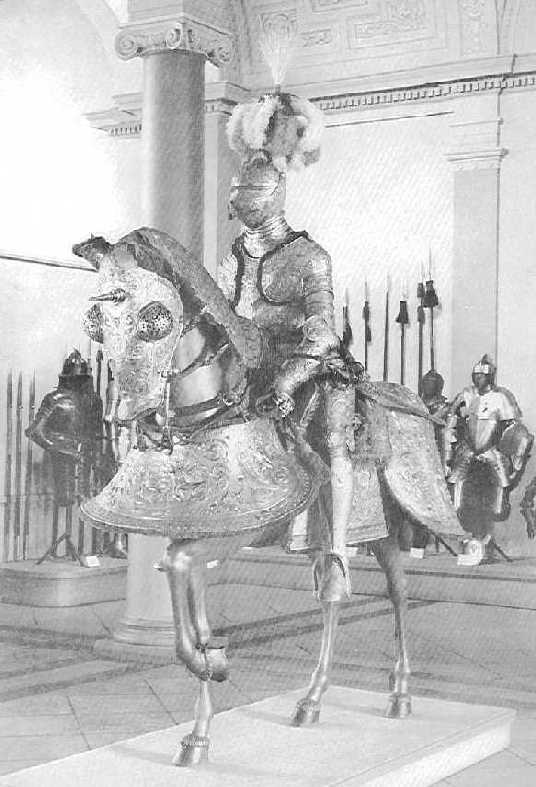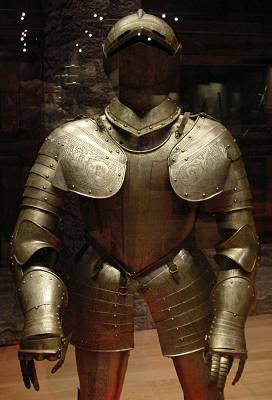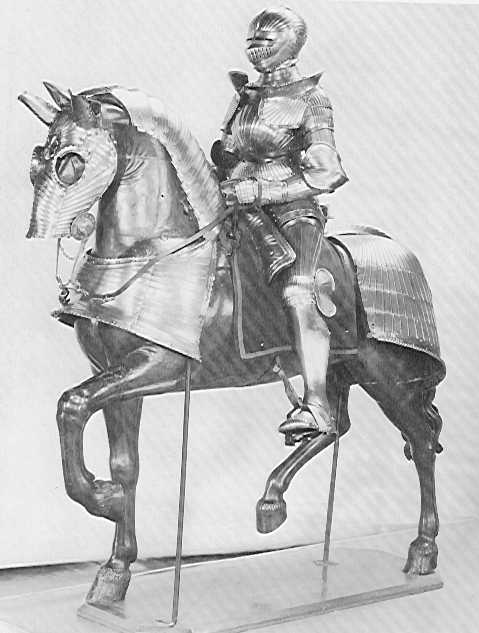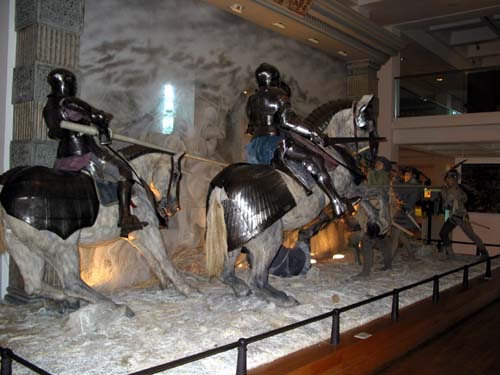| Author |
Message |
Gordon Frye

|
 Posted: Fri 09 Feb, 2007 8:10 am Post subject: Posted: Fri 09 Feb, 2007 8:10 am Post subject: |
 |
|
My belief is that rather than being specifically a protective garment, the bases/waffenrock as used by the gendarmerie was more of a fashion statement. Sometimes the skirt is a part of an over-garment, worn over the armour to both protect the armour and to keep the wearer from feeling the exagerated effects of the ambient temperature (steel is a lousy insulator from the weather), and sometimes it's just the skirt itself. I would imagine that usually in such cases it's just being fashionable. After all, gentlemen's clothing of the period 1500-1550 usually included a based doublet or jerkin/waffenrock, so it makes perfect sense to me that they would wear the same sort of garment in relation to their armour. These WERE men of rank and subject to fashions after all, and not all military fashions in dress are particularly useful or efficient (see "Hussars"  ) That the based skirt could also form a protection for the slightly exposed buttocks and upper back thigh was more of an added benefit, I think, than any sort of well thought out plan. ) That the based skirt could also form a protection for the slightly exposed buttocks and upper back thigh was more of an added benefit, I think, than any sort of well thought out plan. 
They DO look sharp, though, I must admit!
Cheers!
Gordon
"After God, we owe our victory to our Horses"
Gonsalo Jimenez de Quesada
http://www.renaissancesoldier.com/
http://historypundit.blogspot.com/
|
|
    |
 |
Rodolfo Martínez

|
 Posted: Fri 09 Feb, 2007 8:26 am Post subject: Posted: Fri 09 Feb, 2007 8:26 am Post subject: |
 |
|
Well, i have to admit too that a sword or lance can always find its way to the gonads 
It´s a matter of thinking twice to say something to those steel ladies.
Maybe it´s only me, but i think that a certain type of helmet, with plumes, big pauldrons and a waffenrock skirt, gives the soldier some attitude or some kind of psychological effect on the enemy like hussar´s wings and those fearsome samurai helmet and masks.

¨Sólo me desenvainarás por honor y nunca me envainarás sin gloria¨
|
|
  |
 |
|
Lafayette C Curtis
|
 Posted: Fri 09 Feb, 2007 9:30 am Post subject: Posted: Fri 09 Feb, 2007 9:30 am Post subject: |
 |
|
|
Maybe not the pauldrons, but the plumes, banneroles, and skirts were designed at least partially for morale effect. Heavy cavalry (and some light ones too) retained their plumes into the 20th century and the writers of cavalry manuals all agree on what those plumes and bright uniforms were for.
|
|
  |
 |
Rodolfo Martínez

|
 Posted: Fri 09 Feb, 2007 7:36 pm Post subject: Posted: Fri 09 Feb, 2007 7:36 pm Post subject: |
 |
|
Not pauldrons for a morale effect but for a more ¨solid¨ armour. I was wondering, if not a silly question, if a heavy cavalry Gendarme (French, Burgundian, italina, etc...) used those big pauldrons shown in the first photo, and if the second armour can wear bases, or they need a special pattern for the fauld.
Thanks
 Attachment: 48.98 KB Attachment: 48.98 KB

 Attachment: 19.01 KB Attachment: 19.01 KB

¨Sólo me desenvainarás por honor y nunca me envainarás sin gloria¨
|
|
  |
 |
|
Lafayette C Curtis
|
 Posted: Fri 09 Feb, 2007 8:08 pm Post subject: Posted: Fri 09 Feb, 2007 8:08 pm Post subject: |
 |
|
|
Well, if you're asking my amateur opinion, I believe some gendarmes would have worn that kind of pauldron--a plainer version, perhaps, not like the heavily-decorated thing in the photograph. As for the second, I have to admit that I'm not sure I've ever seen a base/waffenrock/whatever attached to a peascod cuirass, but since the thing was a fairly loose garment I would consider it far from impossible. I don't know how likely such a combination would have been, though.
|
|
  |
 |
Rodolfo Martínez

|
 Posted: Sat 10 Feb, 2007 11:16 am Post subject: Posted: Sat 10 Feb, 2007 11:16 am Post subject: |
 |
|
If i´m not wrong the peascod breastplate was a 1550 fashion, that´s why maybe they didn´t used surcoats with those armours. (SeemsI posted the wrong pic  ) )
Do you know if that design of pauldron was used from late XV and early VXI Century till the end of XVI century, or it was a late century fashion too?
Thanks
¨Sólo me desenvainarás por honor y nunca me envainarás sin gloria¨
|
|
  |
 |
|
Lafayette C Curtis
|
 Posted: Sat 10 Feb, 2007 10:20 pm Post subject: Posted: Sat 10 Feb, 2007 10:20 pm Post subject: |
 |
|
|
The pauldron in which picture? The first or the second? The first looks small and mostly unarticulated, so I suppose it's a late 15th/early 16th-century style. The second, being a large and articulated pauldron, was a style that lasted well into the 17th century but I'm not sure about when it first appeared. I don't think I'm aware of any 15th-century examples, though.
|
|
  |
 |
|
Guilherme Dias Ferreira S
|
 Posted: Sun 11 Feb, 2007 11:20 am Post subject: Posted: Sun 11 Feb, 2007 11:20 am Post subject: |
 |
|
|
What your opinion about who had the best harness in the early sixteenth century, the gendarmes (which, I think, used mainly italian armour) or the german gothic knight, in terms of protection against blows from swords and other weapons (It will be useful if someone show information like weight and thickness).
|
|
  |
 |
Rodolfo Martínez

|
 Posted: Sun 11 Feb, 2007 3:17 pm Post subject: Posted: Sun 11 Feb, 2007 3:17 pm Post subject: |
 |
|
Well, if you want more technical info, ask Lafayette or Gordon.
Well, the French had their own style too, wich is similar to italian designs, Check this thread:
http://www.myArmoury.com/feature_delaune.html
If you are talking about a Gothic harness, i can tell you that the fluted surfaces were better to deflect arrows (I think the same goes for the Maximillian style wich, if i´m not wrong is the evolutionary development of the Gothic style) But, as the earlier versions had little pauldrons i think that Milanese style were better for deflecting sword thrusts, or at least it was harder to find the gaps, and thanks to it´s soft round form, i guess it was better against chops. There were both good armours, so i´ll not say that one is better that the other becouse both have their different advantages and disadvantages. For Maximillian style I don´t know how a fluted surface reacts against bullets, but remember that first harquebuzes weren´t very accurate and, as having a round bullet, it slows down quicker, so at certain distance the gun is not very deadly (Of course it still is a deadly armour piercer weapon). The style of armour was a matter of fashion too, so it´s rare to find an entire company with the same style of armour, even French, and Burgundians used Maximillian harness too. The mixture of styles existed too.
 Attachment: 31.77 KB Attachment: 31.77 KB

This is a Gendarme Maximillian style armour.
 Attachment: 37.95 KB Attachment: 37.95 KB

Look the plate covering the horse´s bottom is fluted like in Maximillian style.
¨Sólo me desenvainarás por honor y nunca me envainarás sin gloria¨
|
|
  |
 |
|
Guilherme Dias Ferreira S
|
|
  |
 |
Ushio Kawana

|
 Posted: Mon 04 Jul, 2011 5:04 pm Post subject: Posted: Mon 04 Jul, 2011 5:04 pm Post subject: |
 |
|
Hi all 
I have very simple question... 
When I hear it with "gendarme", I remember Battle of Pavia.
It is famous that they were surrounded and murdered.
I have very simple question about gendarme in Battle of Pavia.
Most of gendarmes are high class nobles. But they did not become captives. (they are killed.)
Why did not they become captives? 
Thanks 
I'm interested in Medieval Arms and Armor.
But... My English is very poor ><;
|
|
  |
 |
Daniel Staberg

|
 Posted: Tue 05 Jul, 2011 2:08 pm Post subject: Posted: Tue 05 Jul, 2011 2:08 pm Post subject: |
 |
|
Pavia is a classic example of what was known as "Bad War", the Spanish and Germans were little inclined to give quarter and take prisoners while the French Gendarmes seems to have resisted with desperate if futile courage. In fact the Imperial cavalry who took the King prisoner had to attack their own men in order to do so. Later on when Francis was escorted of the field by arquebusiers these had to fire up on Spanish infantry who still tried to kill the King.
Previously the French Gendarmes had charged and routed the Spanish cavalry and chased the Spanish who had to run for their lives to find safety in the woods. It is plausible, even likely that the infantry did not do this without losing men who were cut down by the Gendarmes. Seeing this would have increased the ferocity of the Spanish when they were in a position to take revenge.
"There is nothing more hazardous than to venture a battle. One can lose it
by a thousand unforseen circumstances, even when one has thorougly taken all
precautions that the most perfect military skill allows for."
-Fieldmarshal Lennart Torstensson.
|
|
  |
 |
Ushio Kawana

|
 Posted: Thu 07 Jul, 2011 6:32 am Post subject: Posted: Thu 07 Jul, 2011 6:32 am Post subject: |
 |
|
Hi 
Thanks Daniel 
| Quote: | | Pavia is a classic example of what was known as "Bad War", the Spanish and Germans were little inclined to give quarter and take prisoners while the French Gendarmes seems to have resisted with desperate if futile courage. |
I understood the reason.
What are other famous "Bad War"? 
I'm interested in Medieval Arms and Armor.
But... My English is very poor ><;
|
|
  |
 |
Ushio Kawana

|
 Posted: Thu 07 Jul, 2011 2:29 pm Post subject: Posted: Thu 07 Jul, 2011 2:29 pm Post subject: |
 |
|
Hi 
I found... 
http://en.wikipedia.org/wiki/Push_of_pike
* Battle of Ravenna (1512)
* Battle of Novara (1513)
* Battle of Pavia (1525)
* Battle of Ceresole (1544)
But I have new another question. 
I | Quote: | | Pavia is a classic example of what was known as "Bad War", the Spanish and Germans were little inclined to give quarter and take prisoners while the French Gendarmes seems to have resisted with desperate if futile courage. |
"the Spanish and Germans were little inclined to give quarter and take prisoners" is only in the case of this battle(Battle of Pavia)? 
Or it is always(generally) "the Spanish and Germans were little inclined to give quarter and take prisoners"? 
In other words... Did not the Spanish and Germans make knights prisoners compared with British and French? 
Thanks 
I'm interested in Medieval Arms and Armor.
But... My English is very poor ><;
|
|
  |
 |
|
Lafayette C Curtis
|
 Posted: Mon 11 Jul, 2011 10:26 am Post subject: Posted: Mon 11 Jul, 2011 10:26 am Post subject: |
 |
|
| Ushio Kawana wrote: | But I have new another question. 
I | Quote: | | Pavia is a classic example of what was known as "Bad War", the Spanish and Germans were little inclined to give quarter and take prisoners while the French Gendarmes seems to have resisted with desperate if futile courage. |
"the Spanish and Germans were little inclined to give quarter and take prisoners" is only in the case of this battle(Battle of Pavia)? 
Or it is always(generally) "the Spanish and Germans were little inclined to give quarter and take prisoners"? 
In other words... Did not the Spanish and Germans make knights prisoners compared with British and French? :? |
It's just for this battle. The Spanish and Germans in general were no more (or less) reluctant to take prisoners than other nations, but in this battle they got badly mauled by the French early on and they wanted revenge. It's not that different from a modern infantry squad or platoon that had lost many of its men to a sniper or machinegun--they'd kill those bastards if they could get at them, the Geneva Convention be damned.
As for the "bad war" in general, it was already an old phenomenon by the time of Pavia. There were a number of medieval instances where combatants from one side slaughtered their enemies rather than offering quarter, such as the Battle of Worringen (1288, especially the intervention by the peasants near the end of the battle), Courtrai (1302--the Flemish burghers may even have had a standing order to not take prisoners), and the Battle of Agincourt (1415, both during the main phase of the fighting and when Henry V ordered the killing of French prisoners). It's just that the larger scale of warfare in the Renaissance made such incidents more grisly when they occurred.
|
|
  |
 |
Ushio Kawana

|
 Posted: Fri 15 Jul, 2011 10:41 am Post subject: Posted: Fri 15 Jul, 2011 10:41 am Post subject: |
 |
|
Hi 
Thanks Lafayette!
| Quote: | | As for the "bad war" in general, it was already an old phenomenon by the time of Pavia. There were a number of medieval instances where combatants from one side slaughtered their enemies rather than offering quarter, such as the Battle of Worringen (1288, especially the intervention by the peasants near the end of the battle), Courtrai (1302--the Flemish burghers may even have had a standing order to not take prisoners), and the Battle of Agincourt (1415, both during the main phase of the fighting and when Henry V ordered the killing of French prisoners). It's just that the larger scale of warfare in the Renaissance made such incidents more grisly when they occurred. |
Courtrai(Battle of the Golden Spurs) and Battle of Agincourt are famous...
But I knew Battle of Worringen for the first time. So I examine it now...
There are very few sites about this battle... 
ummmmm... why the peasants killed the kights(nobles)? 
And I remembered a similar question in Battle of Fornovo...
from "Osprey: Fornovo 1495" p65-69
| Quote: | | For the French men-at-arms the melee had been a success. For their opponents it had been a disaster; not because they had been routed from the field, but because two different military cultures had resulted in a massacre. During the initial charge, countercharge and melee many men had been knocked from their horses and as the League divisions withdrew, their unhorsed comrades remained on the field. The popular idea that a fully armoured man was unable to rise or remount is a myth, but he would have been winded if not injured, and his horse was probably out of reach. Under such circumstances an Italian men-at-arms normally accepted the fact that he would be captured and have to pay a stiff ransom. The French servants, infantry archers and other support personnel were not, however, interested in ransom. In fact no League prisoners were taken and a horrifying number of Italian men-at-arms were butchered as they tried to surrender. According to Philippe de Commynes, who witnessed the slaughter, it often took three or four Frenchmen using axes, blocks of wood and daggers thrust through narrow visor slits to kill one Italian, the latter's armour being so effective. |
Why were not they interested in ransom? 
Is it this thing? The memoirs of Philip de Commines:
http://www.archive.org/details/memoirsofphilipp02commiala
http://www.archive.org/stream/memoirsofphilip...a_djvu.txt
| Quote: | | We had a great number of grooms and servants with our waggons, who flocked about the Italian men-at-arms, when they were dismounted, and knocked most of them on the head. The greatest part of them had their hatchets (which they cut their wood with) in their hands, and with them they broke up their head-pieces, and then knocked out their brains ; otherwise they could not easily have killed them, they were so very well armed ; and to be sure there were three or four of our men to attack one man-at-arms. The long swords also which our archers and servants wore did very good execution. |
My English is poor... 
So I can't understand sentences, "they broke up their head-pieces, and then knocked out their brains".
I think that the headpiece means the helmets.
Does the "brain" mean "a head" or "a encephalon"? 
Does the "knocked out" means "destroied" or "spurted out"? 
One English word has many meanings and it is difficult for me...
ummmm... It is very terrible how to kill...  
Thanks
I'm interested in Medieval Arms and Armor.
But... My English is very poor ><;
|
|
  |
 |
Michael Curl

Location: Northern California, US Joined: 06 Jan 2008
Posts: 487
|
 Posted: Thu 04 Aug, 2011 12:51 pm Post subject: Posted: Thu 04 Aug, 2011 12:51 pm Post subject: |
 |
|
I would guess that head pieces means helmet
Brain is the english word for the soft stuff inside your head that lets you think and such. I don't know the word for it in japanese, but here is a picture. http://en.wikipedia.org/wiki/Brain
Knocked out means to hit until stuff comes out. So to knock someone's brains out means to hit them in the head till all the organs in their head are on the ground (grissly stuff, very bad).
E Pluribus Unum
|
|
   |
 |
|
Kurt Scholz
|
 Posted: Fri 05 Aug, 2011 4:01 am Post subject: Posted: Fri 05 Aug, 2011 4:01 am Post subject: |
 |
|
| Michael Curl wrote: | I would guess that head pieces means helmet
Brain is the english word for the soft stuff inside your head that lets you think and such. I don't know the word for it in japanese, but here is a picture. http://en.wikipedia.org/wiki/Brain
Knocked out means to hit until stuff comes out. So to knock someone's brains out means to hit them in the head till all the organs in their head are on the ground (grissly stuff, very bad). |
I think that's a misunderstanding. Knock out means that you "knock somebody out of the fight". This can be done by making his brain hit his skull from the inside. How? Accelerate the skull to a speed and direction the brain isn't moving, Newton does the rest.
|
|
  |
 |
Michael Curl

Location: Northern California, US Joined: 06 Jan 2008
Posts: 487
|
 Posted: Fri 05 Aug, 2011 10:23 am Post subject: Posted: Fri 05 Aug, 2011 10:23 am Post subject: |
 |
|
Yes of course but knock means something different when someones says that they are knocking out their brains. A boxer receives a KO, but he doesn't knock someones brains out (unless they are using artistic license, like to say they murdered someone when in actuality they just beat them badly, or saying boxer A was torturing boxer B when in reality he was just beating him up.)
Regardless, if in a melee, your helmet were to come off, I think it would be a real possibility that someone would literally knock your brains out.
Also I'm trying to explain things rather simply, since Mr. Ushio doesn't not speak English fluently.
E Pluribus Unum
|
|
   |
 |
|
Kurt Scholz
|
 Posted: Fri 05 Aug, 2011 12:34 pm Post subject: Posted: Fri 05 Aug, 2011 12:34 pm Post subject: |
 |
|
| Michael Curl wrote: | Yes of course but knock means something different when someones says that they are knocking out their brains. A boxer receives a KO, but he doesn't knock someones brains out (unless they are using artistic license, like to say they murdered someone when in actuality they just beat them badly, or saying boxer A was torturing boxer B when in reality he was just beating him up.)
Regardless, if in a melee, your helmet were to come off, I think it would be a real possibility that someone would literally knock your brains out.
Also I'm trying to explain things rather simply, since Mr. Ushio doesn't not speak English fluently. |
Sorry, sure I agree with you. From an archaeological perspective people killed in war tend to be killed not by one blow and one person, but multiple potentially lethal injuries. The most important of these injuries is usually the disabling one, afterwards the butchering of the defenseless victim starts. Concerning riders this would be the attack against the horse to make the rider fall down or against the legs of the rider to pull him down and unable to rise again because one leg is damaged (For infantry the battle of Visby excavation gives good data of cut legs from behind). Afterwards it's quite popular to knock out an armoured opponent that could still do some injury to his would-be-killers by a stunning blow to the head. The knocked out person is usually butchered in multiple ways by many persons. One possibility is destroying his head so his brain is damaged to the degree of instantaneous death.
That pretty much reminds me of an attempted robbery a friend of mine faced. A gang surrounded him and suddenly he received a hard blow to the head he didn't see coming. After he was dizzy from this blow all gang members at once started beating him. After having made him a helpless victim this way they demanded that he gets them money from the bank. But they could just as well have killed him. That all happened despite he's a very well-trained guy who later served in one of the elite units of our military. So Medieval killing on the battlefield and modern gang violence do have things in common.
|
|
  |
 |
|
|
You cannot post new topics in this forum
You cannot reply to topics in this forum
You cannot edit your posts in this forum
You cannot delete your posts in this forum
You cannot vote in polls in this forum
You cannot attach files in this forum
You can download files in this forum
|
All contents © Copyright 2003-2024 myArmoury.com — All rights reserved
Discussion forums powered by phpBB © The phpBB Group
Switch to the Basic Low-bandwidth Version of the forum
|

